You know that feeling when you see a brand new competitor swooping in and snatching leads away from you?
It can make you start questioning your whole approach.
But instead of panicking, it’s far more useful to break down what they’re doing.
That way, you can cherry-pick their best ideas. And spot the gaps they’ve missed.
This post will show you exactly how to do that.
As you read it, imagine you’re a new pet supplies brand going head-to-head with the retailer Hollywood Feed.

To get the upper hand, you’ll need to understand how they’re driving traffic and converting customers, answering questions like:
- Which channels bring the most visits and sales?
- How much of their traffic is organic vs. paid?
- Which pages, platforms, and campaigns are working best?
In this guide, you’ll learn how to run a competitor analysis to find the answers to these questions and more — regardless of your brand, industry, and experience.
Free resource: You can follow along with our Competitive Analysis Worksheet. Just open it up in another tab, and use this article as a guide to fill it out for your top 3-5 competitors.
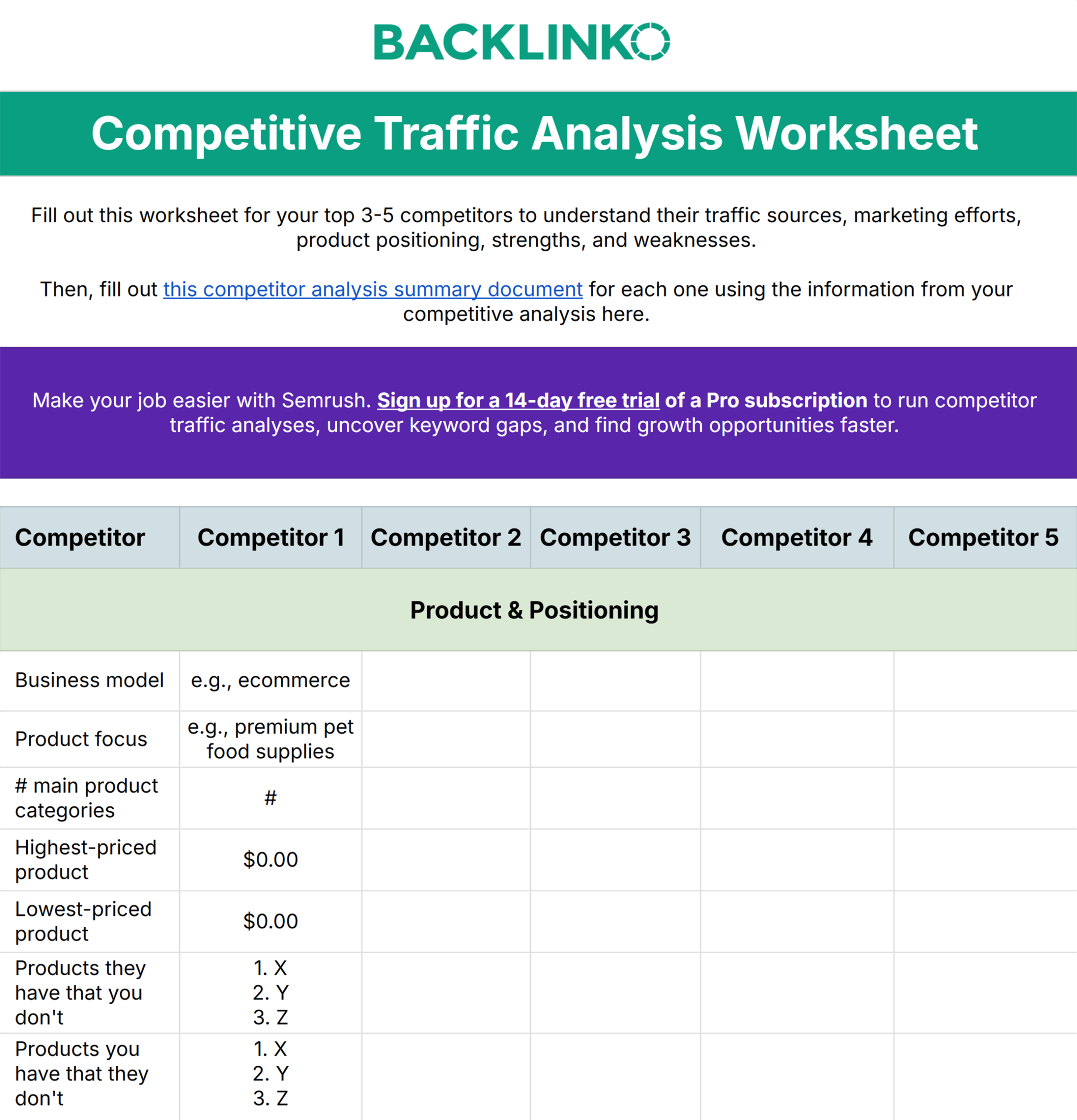
Before you start, this guide assumes you’ve already covered the basics.
You know your ideal customer. You’ve nailed your positioning. You’re clear on the category or niche you’re competing in.
If not, start here: The Complete Guide to Market Research
It’ll make everything in this guide way more useful.
Let’s start by identifying your real competition.
Step 1: Spot the Competitors Grabbing Your Traffic
You need to build a live list of 5–10 competitors.
Begin Googling broad, high-intent terms like:
- “best dog food”
- “pet store near me” (or “pet store in [city]”)
- “cat toys online”
Not sure where to start? Try this AI prompt to gather some terms you can then type into Google:
“What high-intent keywords do people use when searching for [your product/service] online?”
Make a note of:
- Who ranks organically
- Who’s running paid ads
- Who’s in the local pack (map section that shows nearby businesses) or shopping results
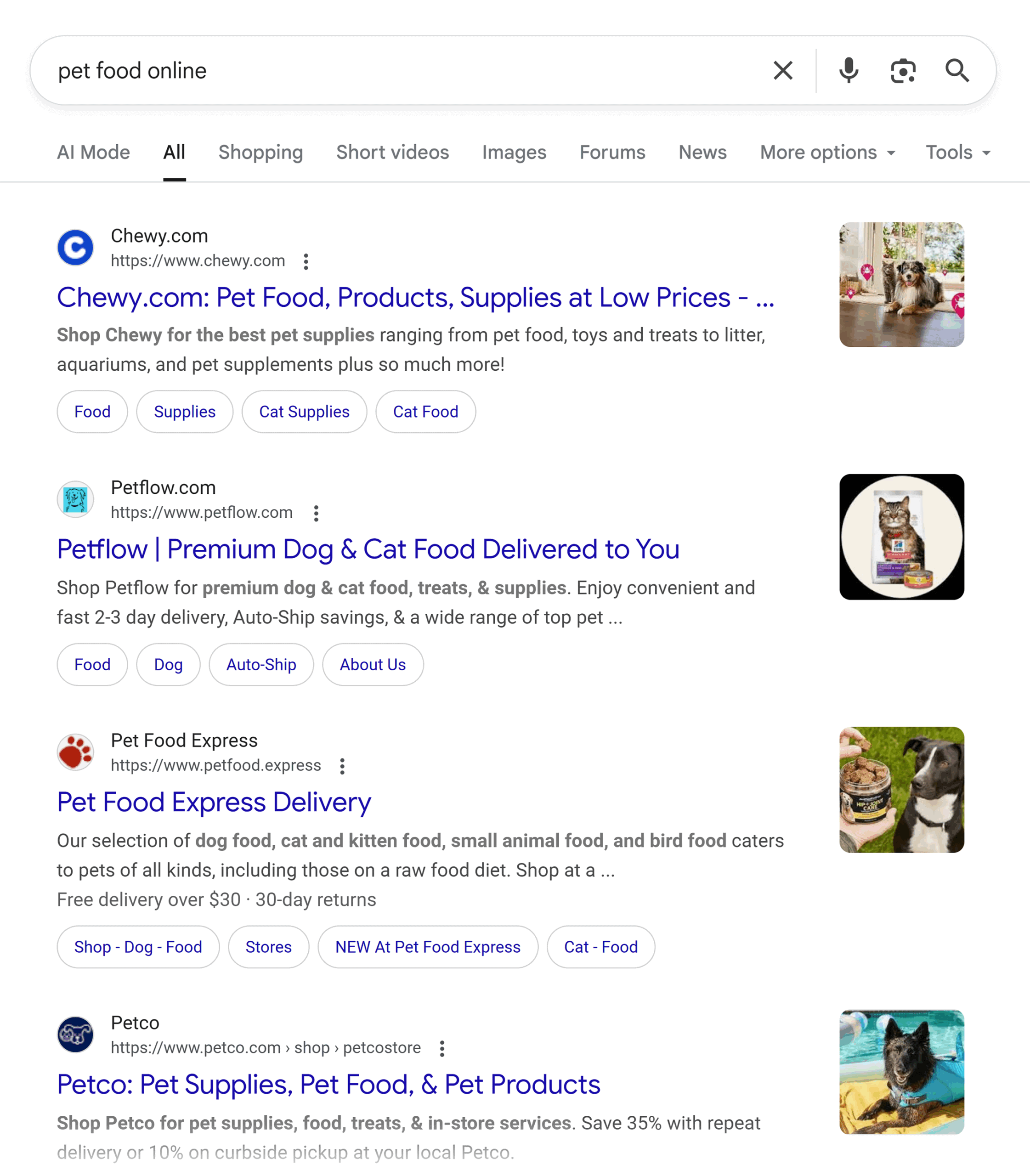
Next, check out popular Reddit threads and pet owner forums. This is where you’ll often find smaller, more niche brand mentions. But they might still be your competitors depending on your location and/or stage of growth.
(As a bonus it’ll also often reveal the sentiment around your rivals from real customers.)

Now go to Google and look for “best of” listicles from publishers and bloggers.
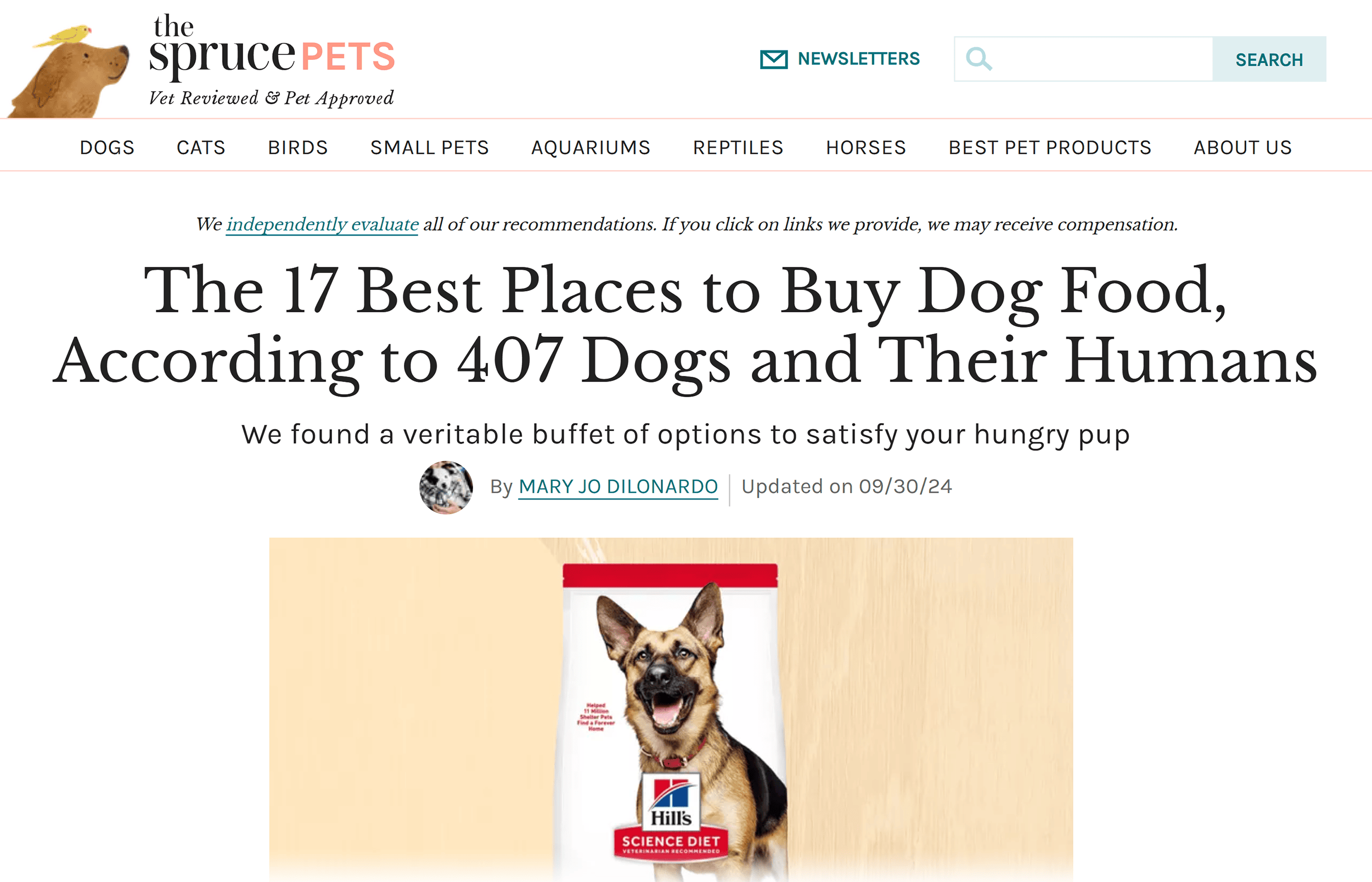
Find these by searching for modifiers like “best” and “cheapest” followed by:
- [product] in [industry]
- [product] in [city]
- [product] for [specific need]
- [product] under $[amount]
- [product] in [year]
- [industry] brands
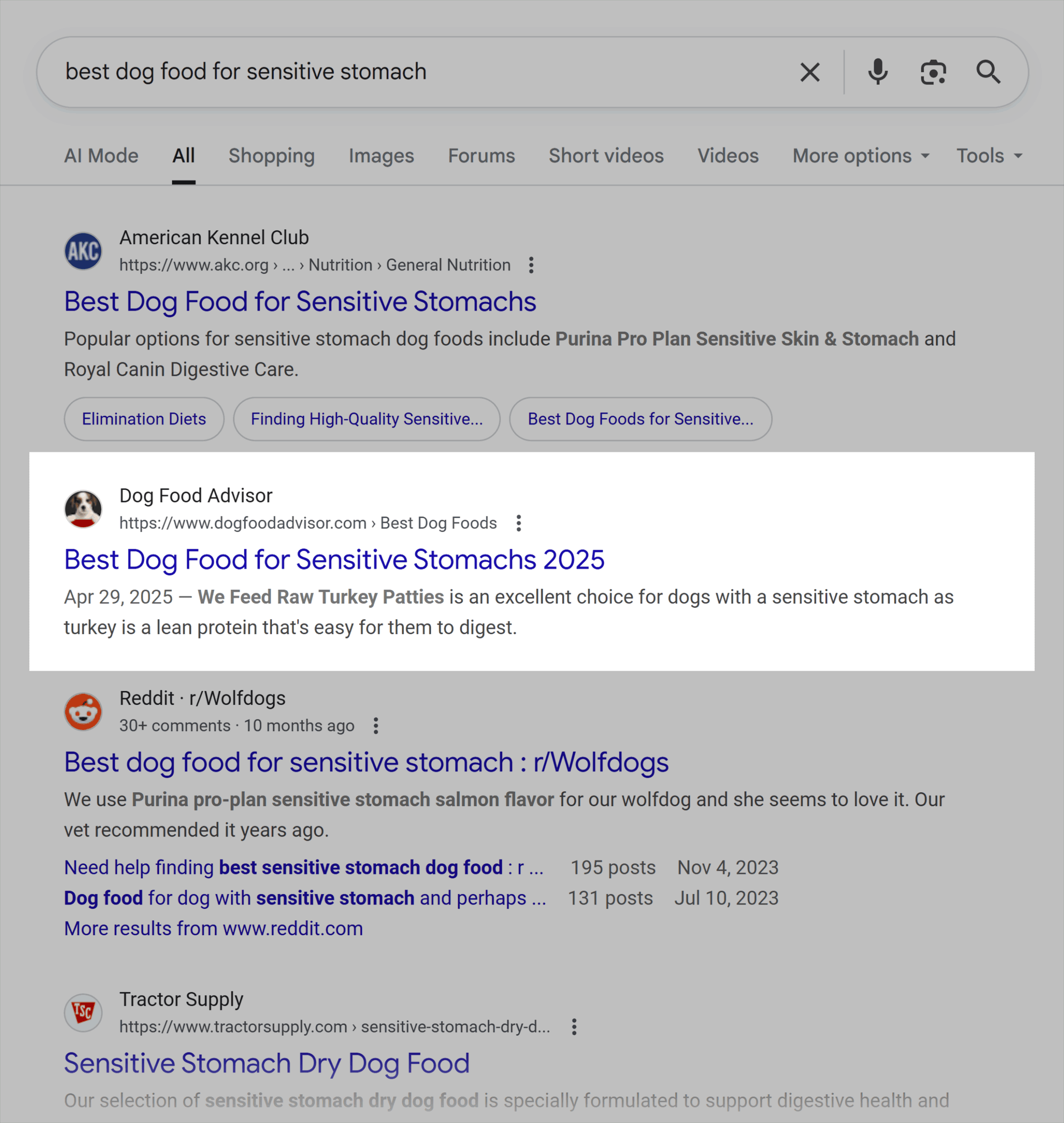
Tip: Also check which competitors rank for these terms directly. These are generally high volume, competitive, and valuable. If your rivals rank for them, you likely want to as well.
Want a more straightforward way to find your rivals?
You can use an SEO platform like Semrush to instantly find your main competitors.
Just pop your domain into the Organic Research tool. Head to the “Competitors” tab and you’ll see the Competitive Positioning Map.
This shows your top rivals on a chart of the number of keywords they rank for vs. their organic search traffic.
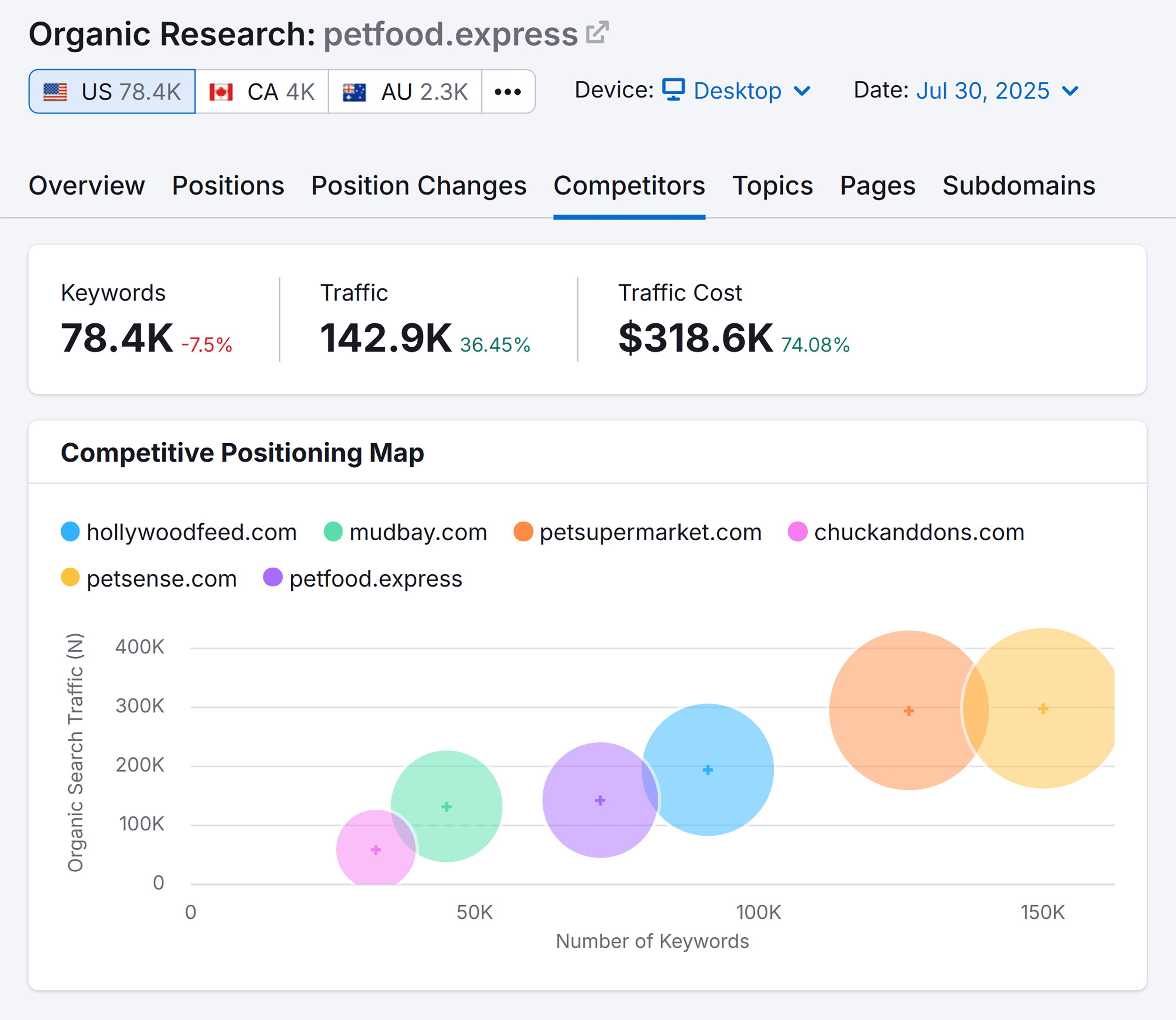
You’ll also see more information below that about each competitor. Like common keywords, paid keywords, and more.
Note: A free Semrush account gives you 10 searches in the Organic Research tool per day. Or you can use this link to access a 14-day trial on a Semrush Pro subscription.
Finally, AI tools like ChatGPT can help uncover competitors that traffic tools might miss. Here are a few prompts you can try:
| Use Case | Example Prompt | What It Reveals |
|---|---|---|
| General Discovery | What are the best places to buy [your product] in [your market]?
E.g. What are the best places to buy pet supplies online in the U.S.? |
Returns top names, but might sometimes surface lesser-known brands too |
| Niche-Specific | Top-rated [your business] for [your niche] in [your market]
E.g., Top-rated pet stores for natural dog food in the U.S. |
Highlights specialty brands focused on natural or premium products |
| Emerging and Hidden Players | Fastest-growing [your vertical] business in [your market]
E.g., Fastest-growing pet retailers in the US |
Surfaces rising brands that may not rank in traffic tools yet |
Note that AI tools may personalize answers based on your chat history. Run prompts in a fresh window, and always verify unfamiliar results.
Pro tip: It’s easy to watch the big names and miss smaller players like Hollywood Feed who are gaining ground.
Don’t just check Google.
Search Reddit, niche listicles, and online communities to spot emerging competitors.
Reminder: Add these competitors to your copy of our competitor analysis worksheet.
Step 2: Find Your Edge by Comparing Products and Positioning
Once you’ve got your competitor list, go through them one by one, and start by looking at the basics:
- What products do your competitors sell?
- How do those products compare to yours?
Then, look at how they talk about themselves.
What value propositions are they leaning on: quality, price, convenience, or something else?
Head to their website to find this out.
Have a click around, paying particular attention to the product and category pages. Use what you find to fill out the “Product and Positioning” sections of our template:

You can use AI to gather a lot of this info even faster (although I still recommend actually visiting their website too).
Here’s an example of a prompt you could use:
I’m analyzing competitors to understand how to position my brand more effectively.
Here’s what I’d like help with:
- My brand: [insert brief description — product, audience, values]
- Competitors: [insert 3–5 competitor names]
For each competitor, please:
- List their main products
- Compare their offerings to mine in terms of variety, pricing, target customer, and positioning
- Identify their core value propositions (price, convenience, quality, speed, etc.)
- Describe their messaging tone and website language
Then suggest 2–3 ways I can differentiate — based on gaps or overlaps in their positioning. Format your answer using tables and bullet points
Here’s an example using Hollywood Feed and Chewy:
| Section | Brand | Details |
|---|---|---|
| Product Comparison | Chewy | Wide selection: pet food (all types), toys, meds, grooming. Convenience-focused. |
| Hollywood Feed | Natural/premium food, boutique accessories, regional in-store experience. | |
| Value Propositions | Chewy | Convenience, speed, selection, 24/7 service. |
| Hollywood Feed | High quality, local expertise, boutique service. | |
| Messaging & Tone | Chewy | Warm, mass-market tone. “Trusted by millions.” Friendly and supportive. |
| Hollywood Feed | Expert-led, local authority. “Nutrition-trained associates.” Boutique feel. | |
| Differentiation Opportunities | 1. Sustainable + subscription niche | Neither competitor clearly owns this space — potential to stand out. |
| 2. Ingredient transparency | Competitors mention quality, but don’t emphasize traceability or sourcing. | |
| 3. Radical simplicity | Chewy offers everything; Hollywood Feed is regional. There’s room for a frictionless, curated experience. |
Note: We’ve included a section at the end of the downloadable worksheet to go a step further and analyze your rivals’ customer experience and checkout flows.
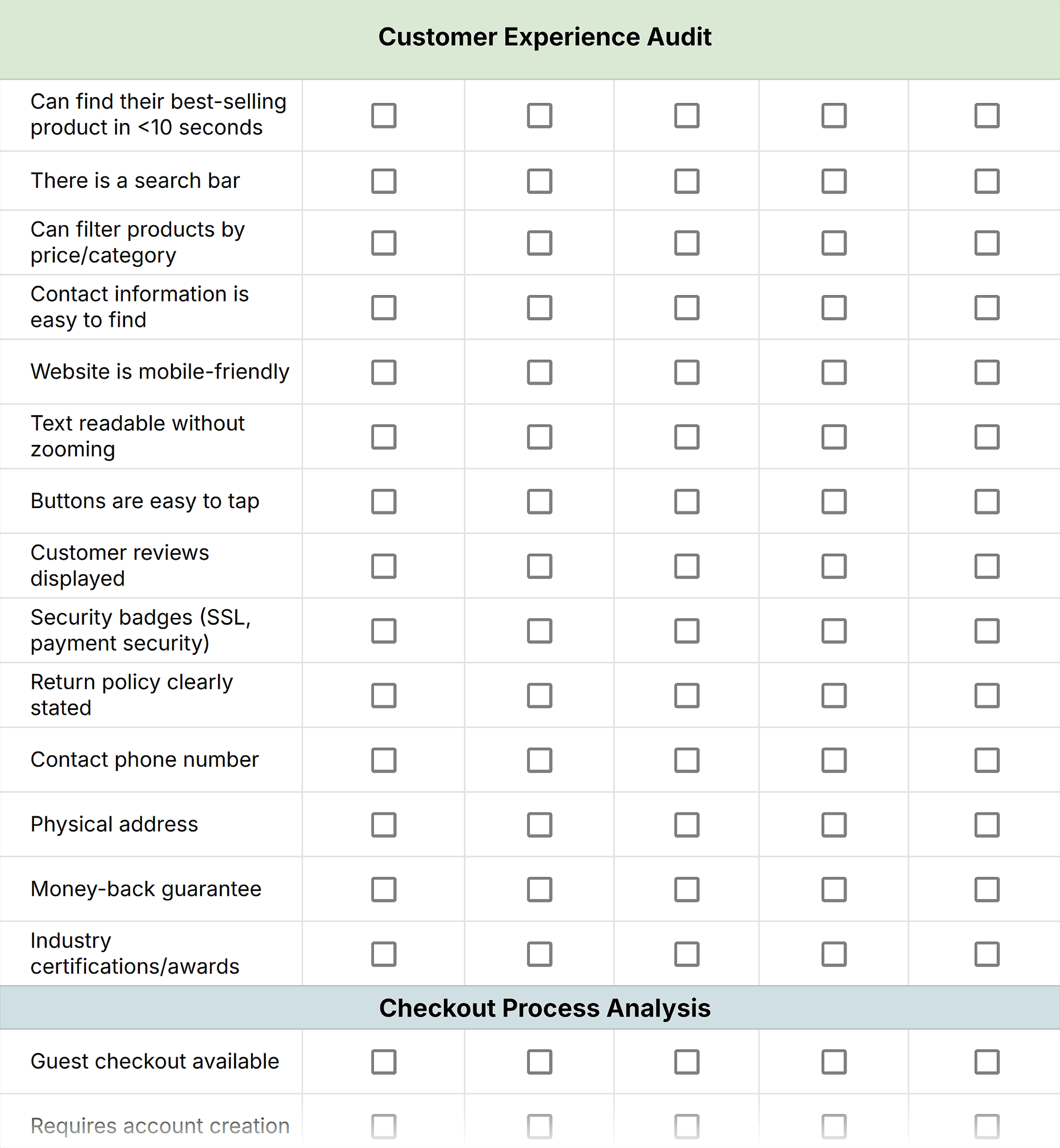
There are too many checks to cover in detail here. But they’re still super important as they can help you understand where your rivals are winning at the end of the buyer journey.
Step 3: Analyze Their Traffic Channels
Looking at your competitor’s website traffic can tell you where they’re investing. And how fast they’re growing.
Here’s how.
Start with the Top-Level Traffic Numbers
Start by checking competitor website traffic in general. You can do this with a tool like Semrush’s Domain Overview (although there are other options out there — including our own free website traffic checker).
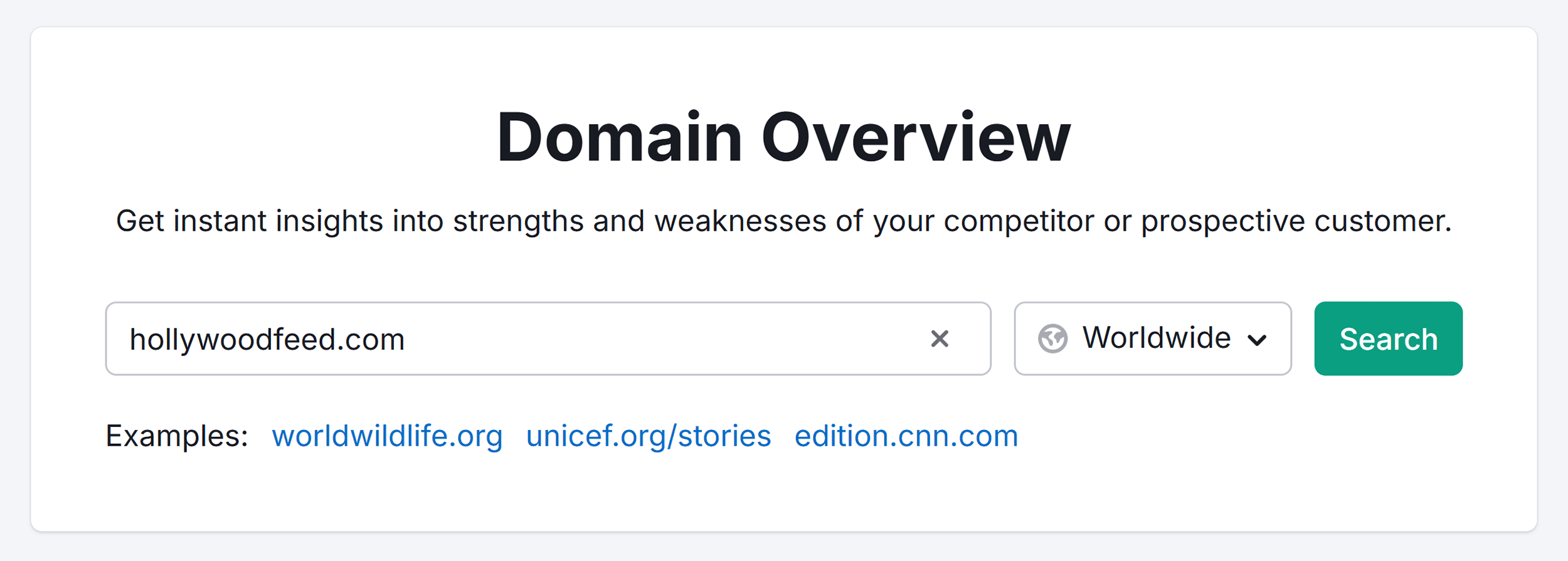
Here’s what to check:
Total Traffic
Look for their estimated monthly visits.
A higher number doesn’t always mean more sales.
But it does show the scale of their online presence.
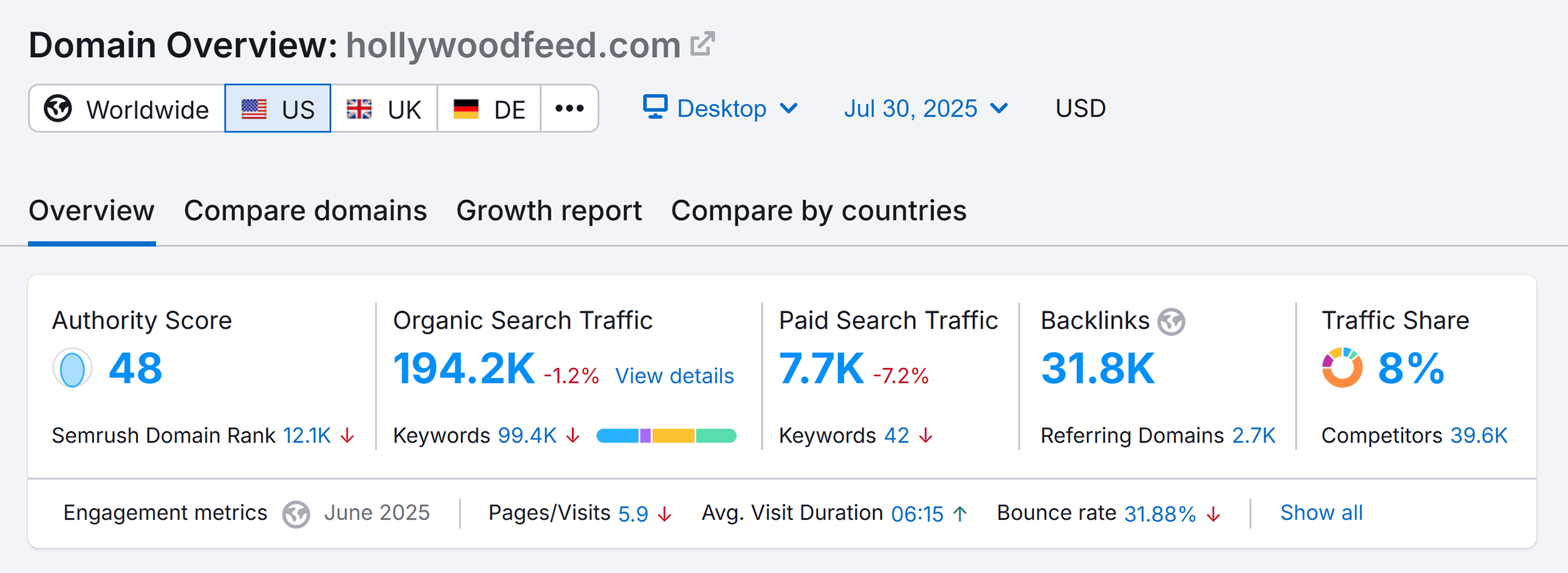
For example, Hollywood Feed has around 193K organic visits per month. That’s a significant number to contend with if I’m a new player, and I shouldn’t expect to reach that number overnight.
Paid vs. Organic
Comparing paid traffic to organic traffic reveals how your rivals are acquiring customers.
A brand with mostly organic traffic is typically investing in SEO and content.
A brand leaning on paid search or social is buying quick traffic. But they may be vulnerable to rising costs.
Hollywood Feed brings in only 8.4K from paid search. It looks like they’re betting on SEO over ads.
If your pet store has the budget to invest in paid search, you could reach customers they’re missing.
Further reading: Learn more about using paid ads effectively in our guide on advertising your business.
Traffic Share
Use traffic share metrics to compare competitor website traffic and understand where you fit in the picture.
For example, Hollywood Feed holds a 9% traffic share compared to its main competitors.
They’re a meaningful player in the market, but not the dominant one.
Branded vs. Non-Branded
Are people searching for their brand name or just looking for what they sell?
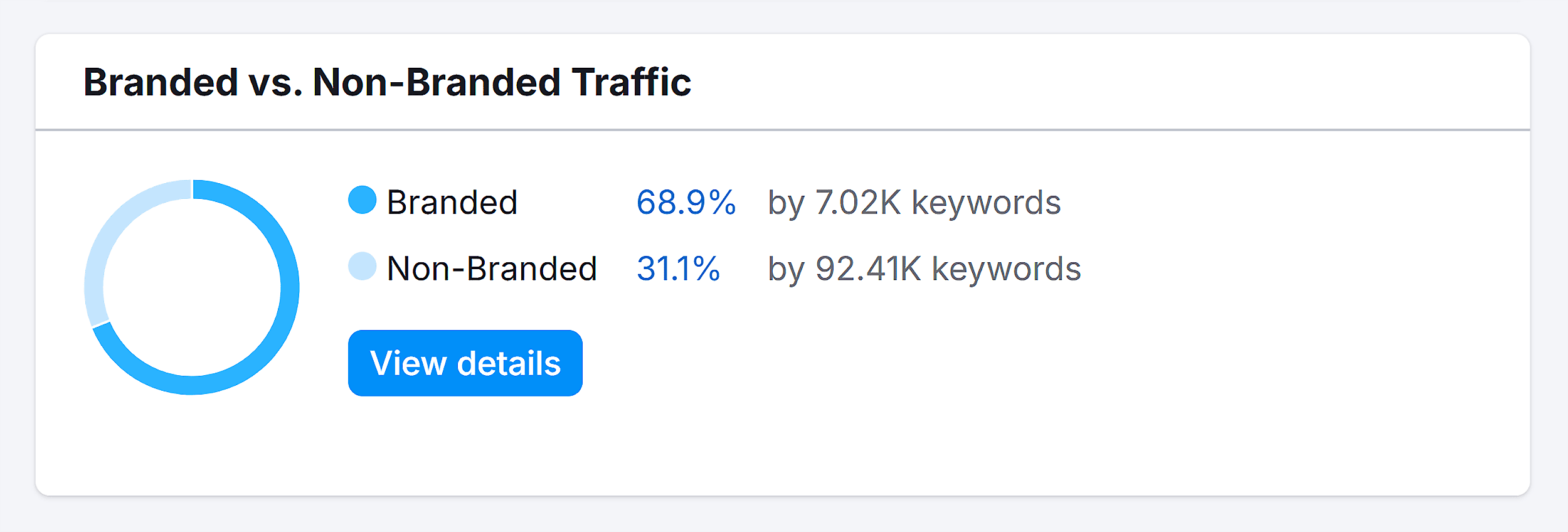
Hollywood Feed gets 68.1% of its traffic from branded keywords.
That shows strong name recognition but also reveals an opportunity.
Aim to rank for the non-branded, high-intent searches they’re missing.
Analyze Their Traffic Split
Moving away from just traffic, you can learn a lot about your competitor’s SEO and content marketing strategy from the outside.
You can do this with Semrush’s Organic Research tool.
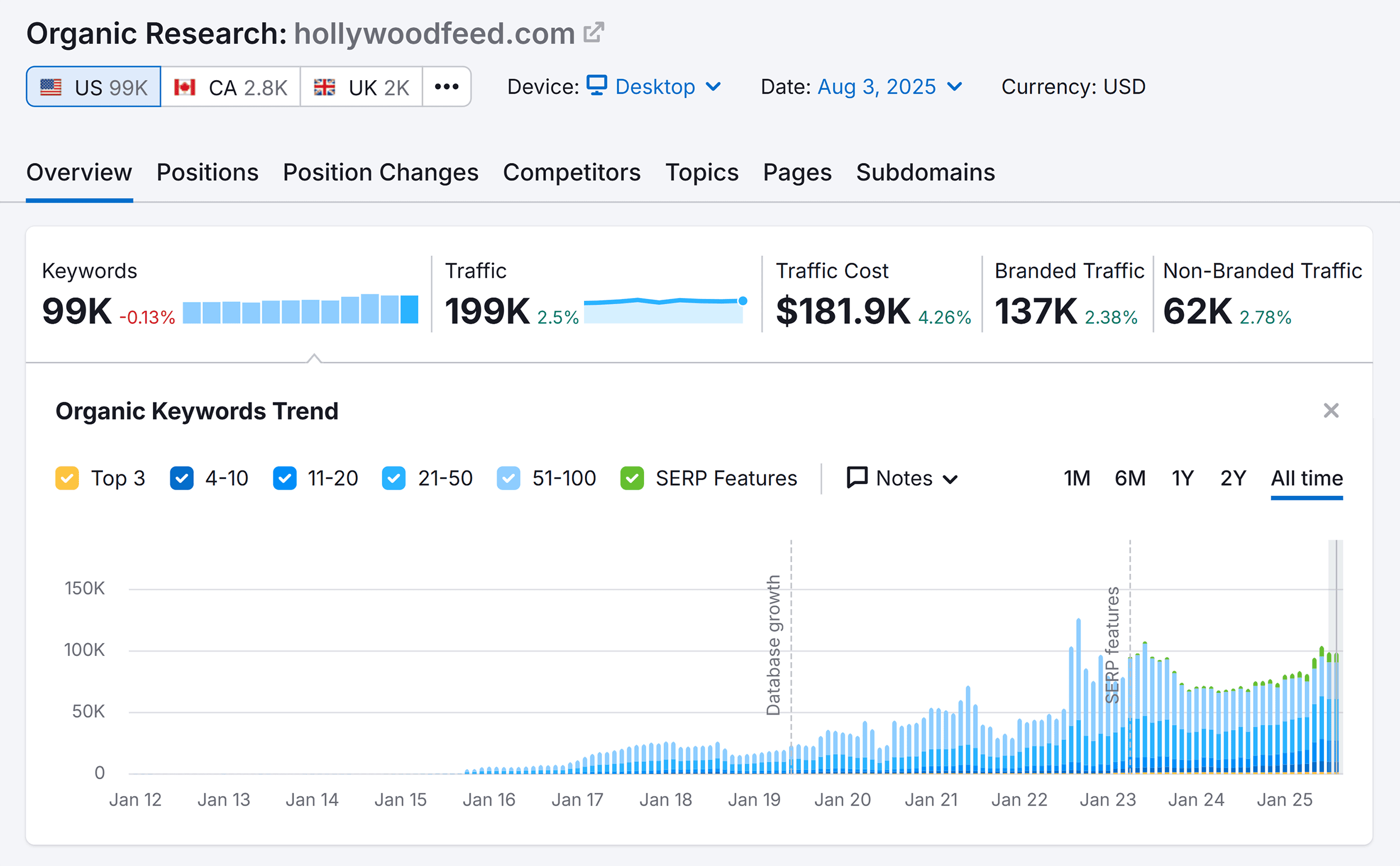
Scroll down to see their top pages.
Are they blog posts, category pages, product pages, or store locators?
This helps you spot where they’re strongest, and where there might be opportunities.
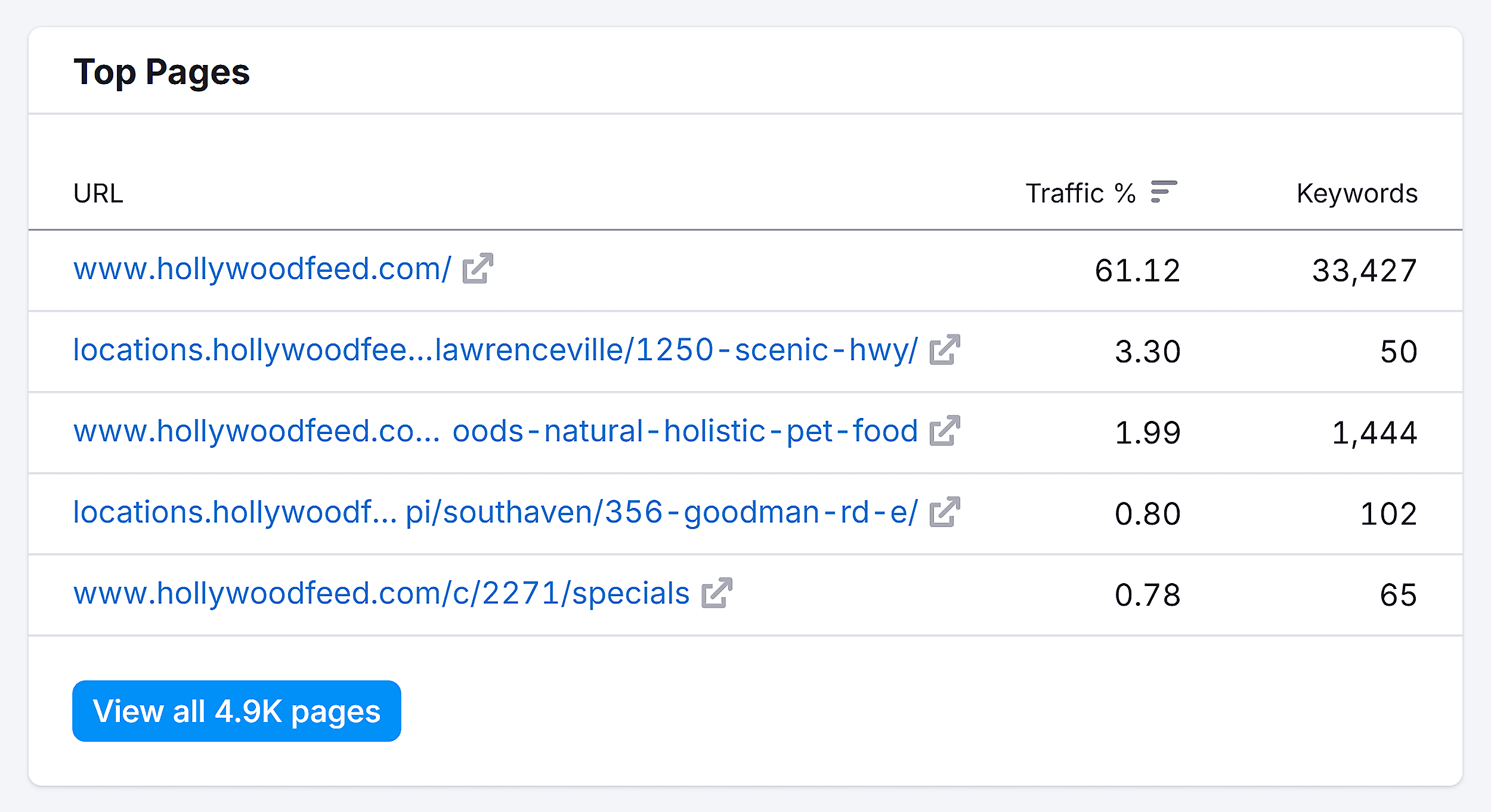
For example, 61% of Hollywood Feed’s traffic goes to their home page.
This suggests strong brand recognition but potentially limited organic discovery.
Their location pages also drive some traffic, suggesting investment in local SEO.
Blog content contributes less than 3% of visits.
So there’s a chance to compete on content.
Next, look at their Keywords by Intent:
- Informational keywords represent people looking for advice
- Navigational keywords come from people searching for a specific site
- Commercial keywords are searched by those comparing products
- Transactional keywords are used by shoppers ready to buy
Note: Traffic numbers can look impressive, but context matters. A competitor with 200K visits might not be a real threat if most traffic is just browsing educational content. Focus on traffic quality and intent, not just volume.
Here’s the breakdown for Hollywood Feed:
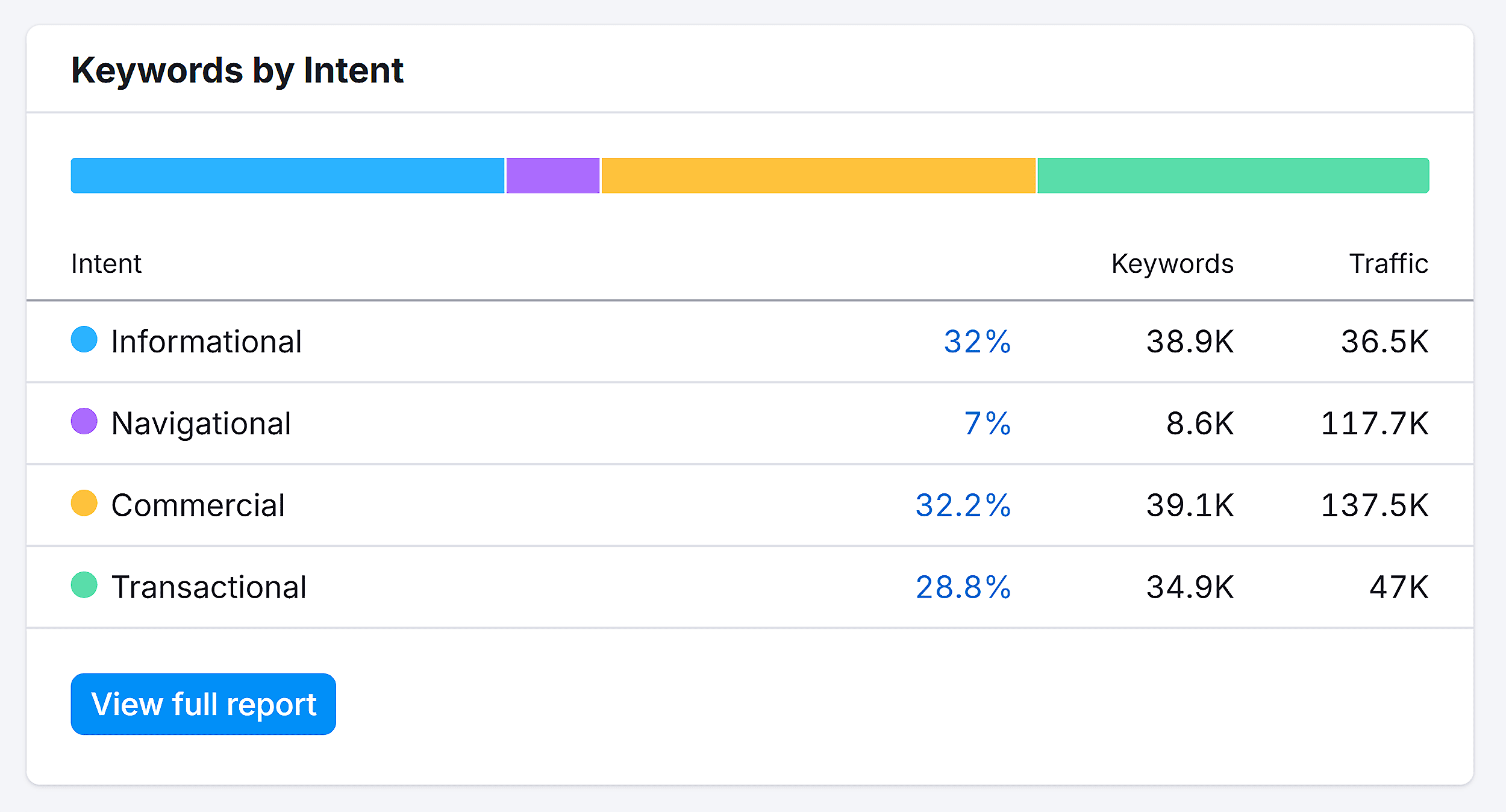
Their keywords primarily cover informational, commercial, and transactional intent. And it’s a pretty even split.
This means they reach searchers at every stage of the buying journey.
No obvious gaps here.
But as they’re evenly spread, you could consider going deeper on one keyword set to compete.
For instance, better product comparisons could help you compete for commercial keywords.
Further reading: For more tips on finding these opportunities, check out our full guide to uncovering competitor keywords.
Step 4: Look at Their Paid Media Performance
Next, check how your competitors are using paid media to drive traffic and sales.
Start with Google Ads.
Search for their brand name to find branded search ads.
Also, look for relevant non-branded keywords. Like “natural dog food” or “best dog treats.”
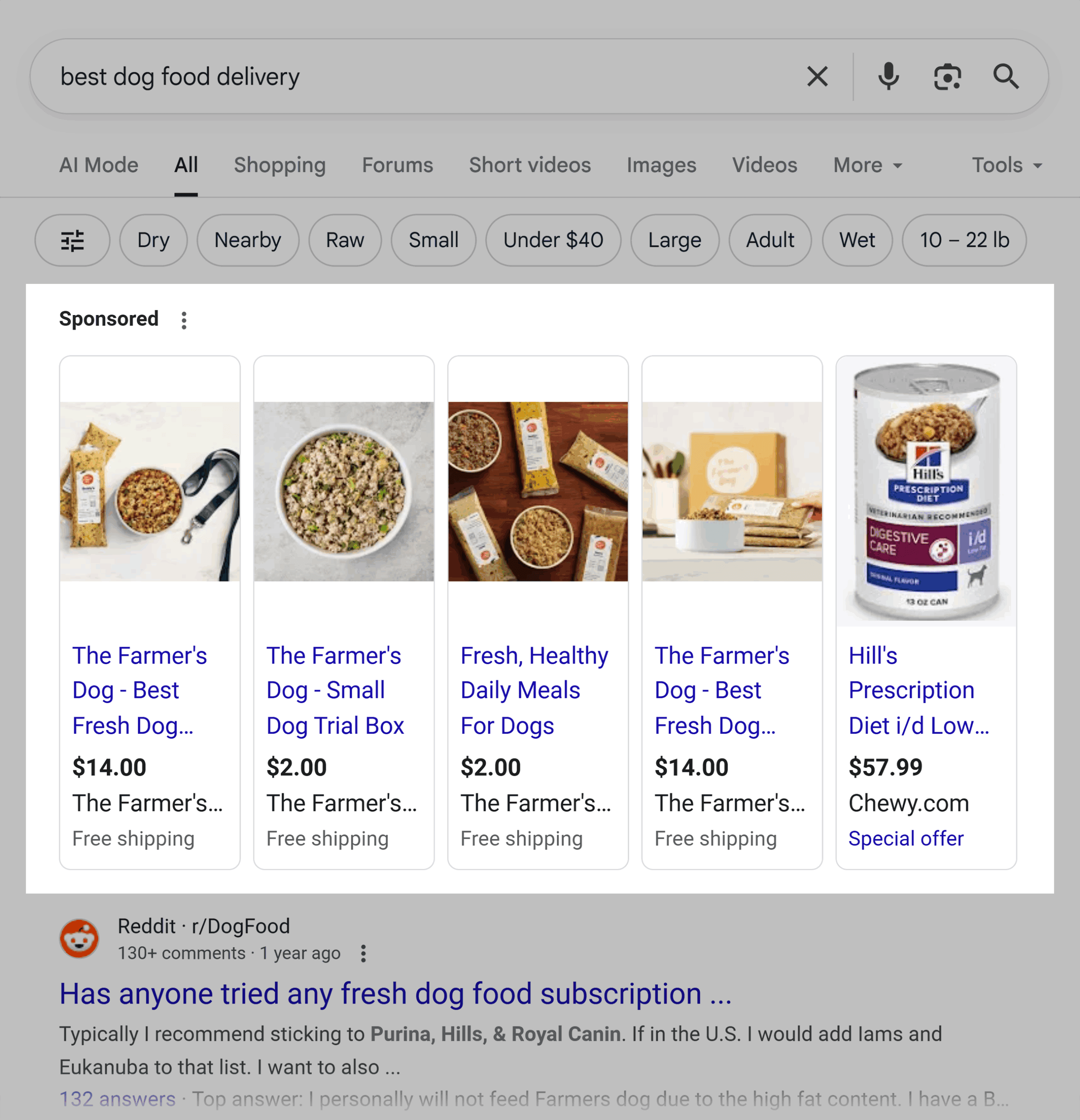
Look for Google Search ads and Google Shopping ads (product images with prices).
Pro tip: Use Google’s Ads Transparency Center to browse a brand’s live and past ads.
Next, visit the Meta Ad Library and type in their brand name.
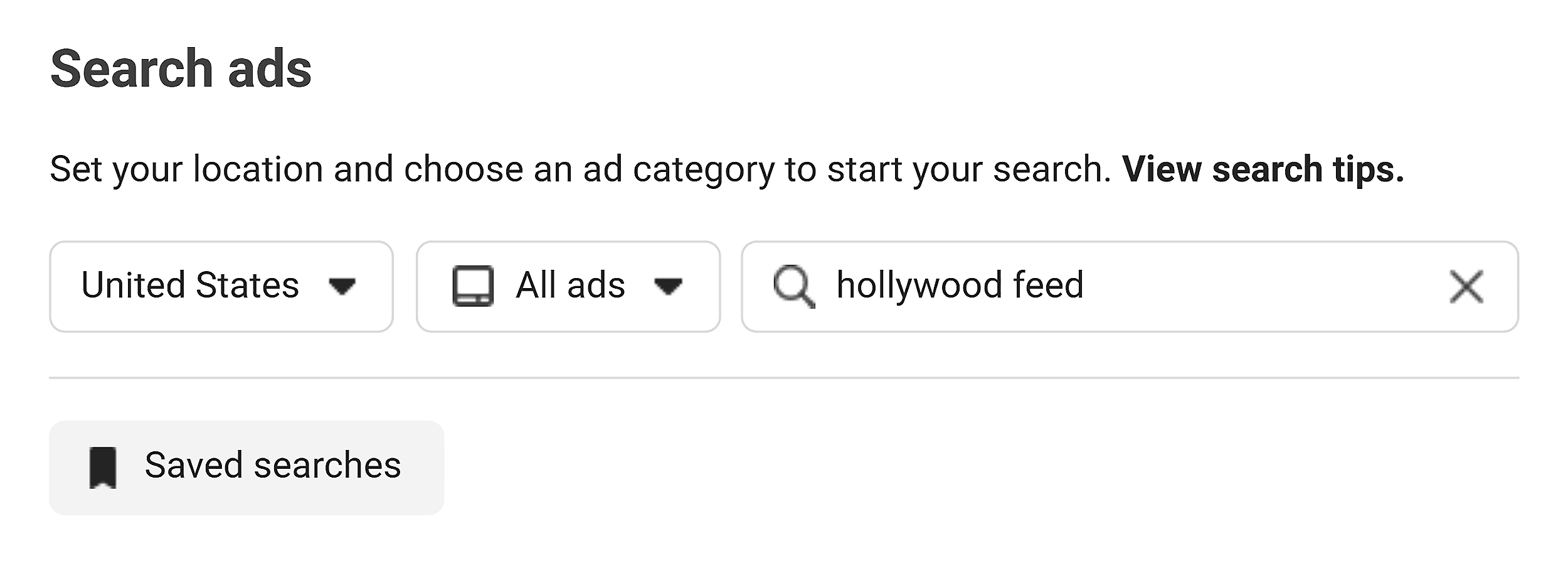
This will show you any active ads they’re running on Facebook or Instagram.
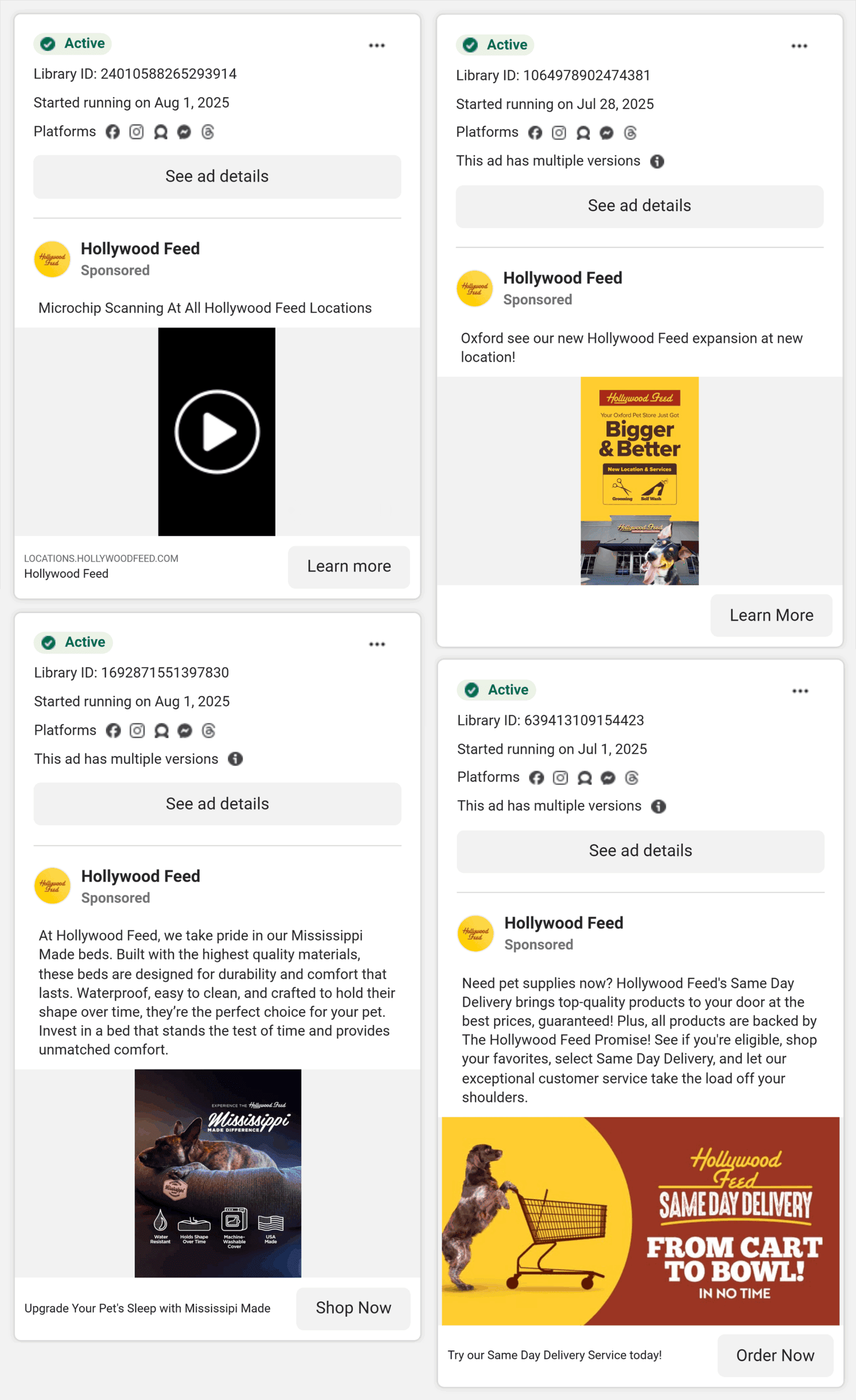
You can do the same on TikTok’s Ad Library.
As you review their ads, pay attention to:
- What products they’re promoting (specific brands, seasonal items, top-sellers)
- What offers they’re using (discounts, bundles, subscriptions, free shipping)
- Which platforms they’re investing in (Google, Facebook, Instagram, TikTok)
This gives you a snapshot of their paid strategy on social media.
Hollywood Feed’s Meta ads are a mix of product promotions and local messages.
You could stand out by using stronger calls to action.
You might also try content-driven ads or user-generated videos to boost engagement.
Further reading: You can also use this free Competitor Search Ads tool to spy on your competitors’ ads.
Step 5: Deep Dive Into Their Content and Messaging
Take a closer look at how your competitors are talking to their audience.
Start with their homepage copy.
Is it clear who they’re targeting and what makes them different?
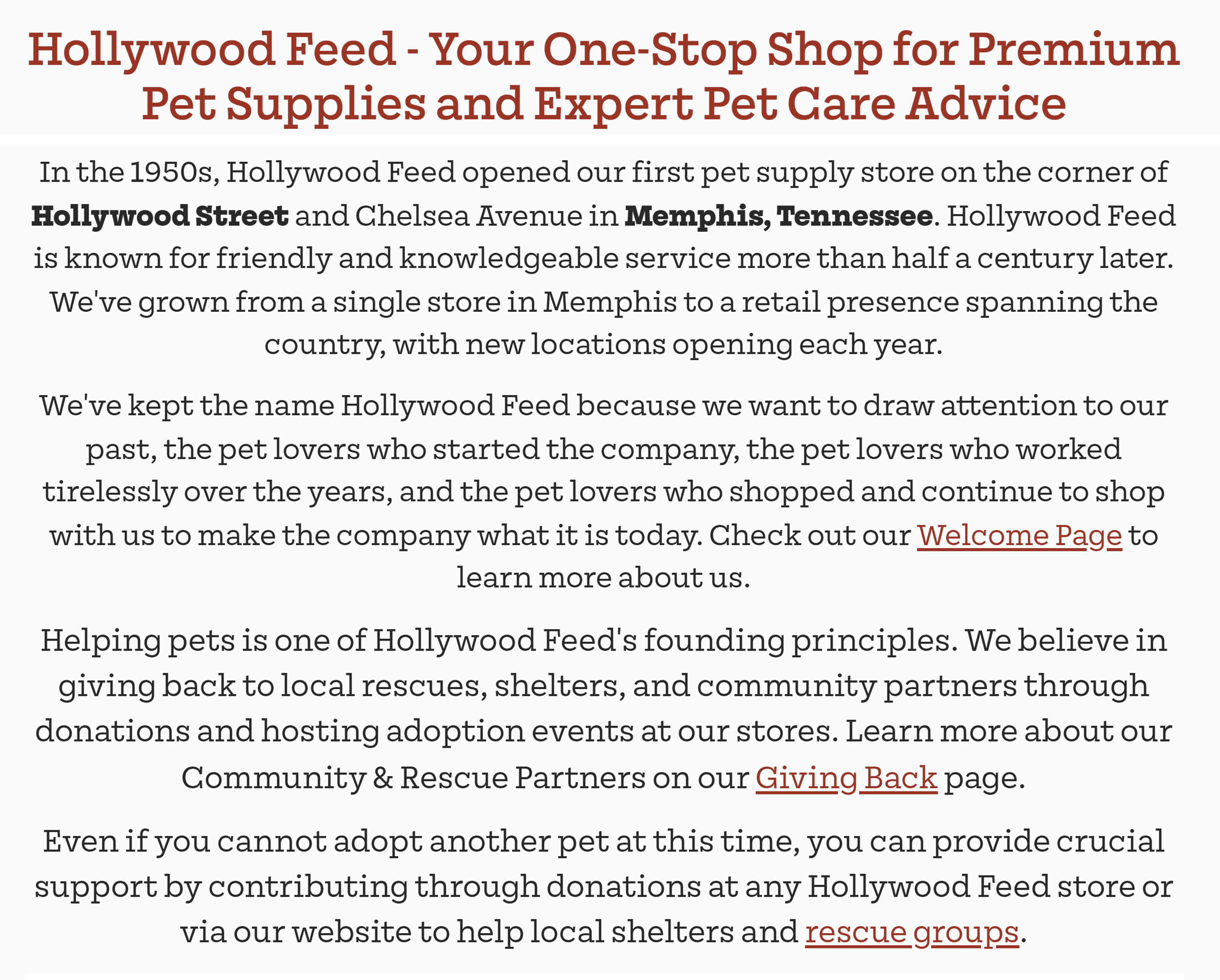
Hollywood Feed does a good job of highlighting benefits upfront.
Same-day delivery. Curated product picks. “Why we’re a different breed” messaging.
It’s all there — baked right into the homepage.
Steal that move.
Make sure your top benefits are front and center.
What makes you different? Why should someone buy from you instead of the competition?
If that’s not obvious in the first few scrolls, fix it.
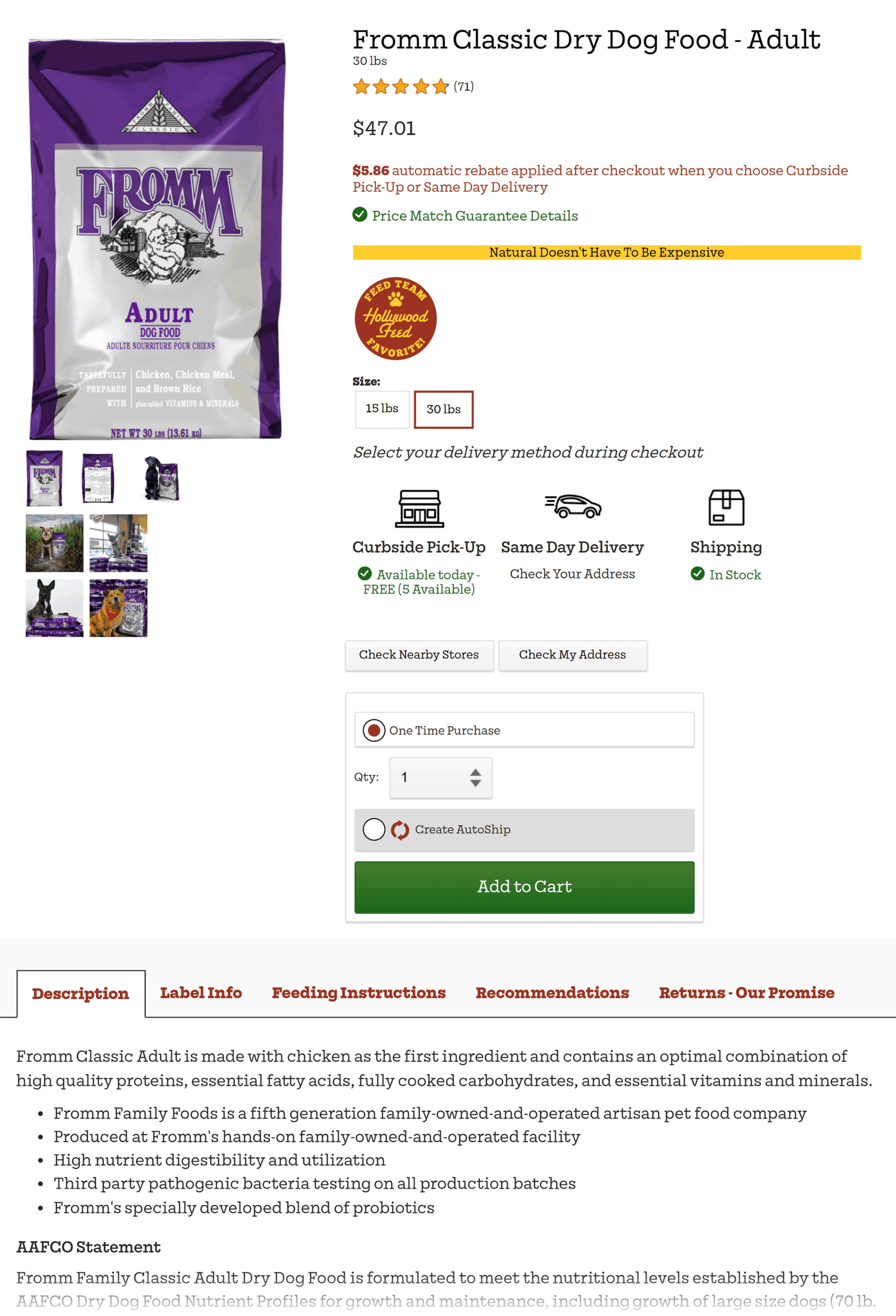
Also analyze their:
- Product descriptions: Are they just listing features, or are they showing how their products solve problems? Do they use benefit-driven language?
- Blog/educational content: Is their content deep, or is it thin and only covering the basics? Could you create more engaging, valuable blog posts for your audience to outrank and outcompete them?
- Tone, style, and trust signals: Do they prominently feature social proof? Do they show off guarantees or certifications/awards?
Finally, look into their content structure.
Topic clusters are groups of related articles linked to a central pillar page. This can help build authority around key topics.
The Hollywood Feed University blog covers topics like pet care and nutrition.
But they haven’t built out strong topical clusters to organize this content.
When you click on a category, you get a list of articles, not a central pillar page.
That’s a missed SEO opportunity — and a chance for you to win.
Create clear pillar pages that link out to related content.
It helps Google understand your site and builds topical authority.
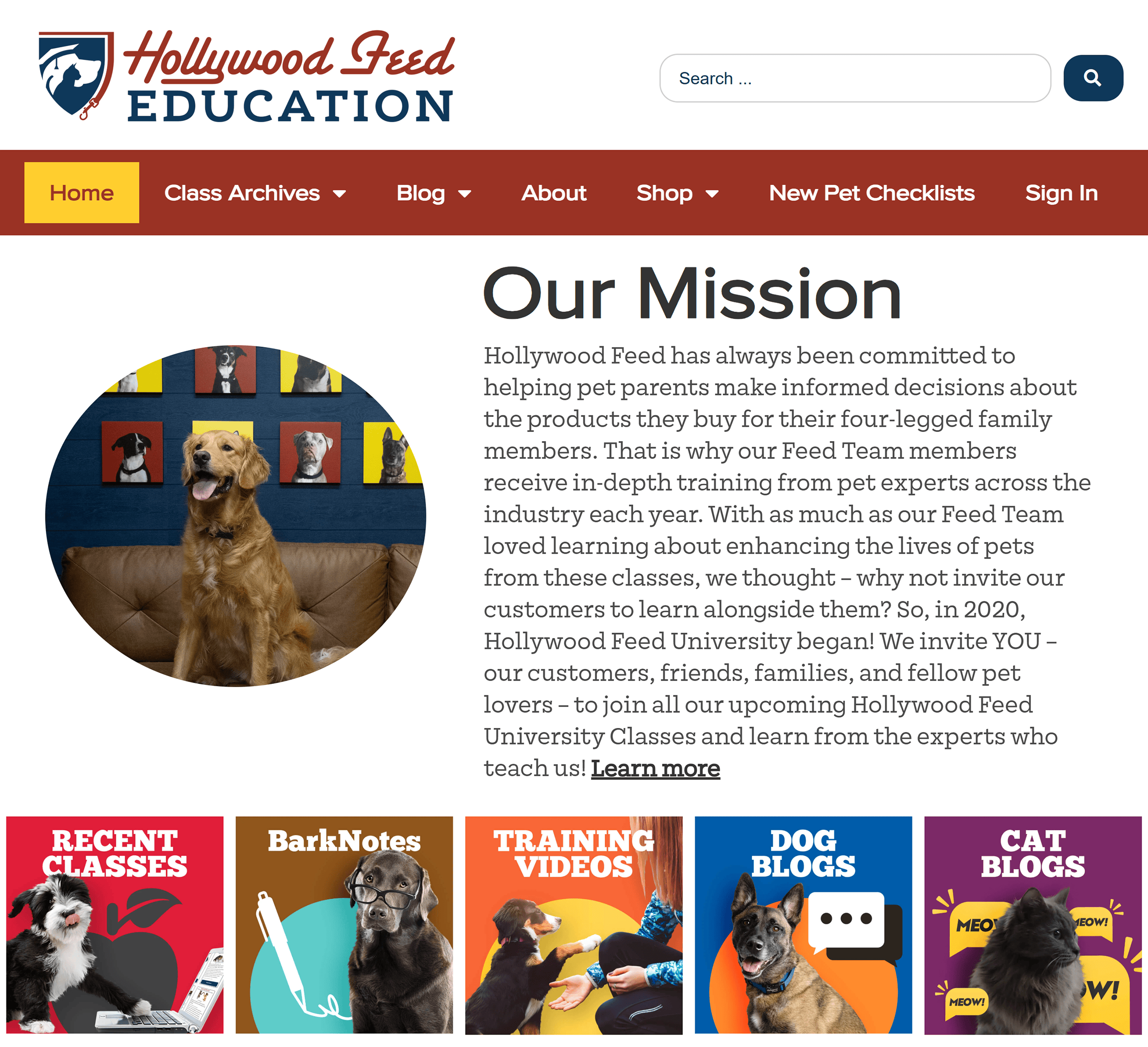
Compare the insights you gather with your own content to identify areas you can improve — and gaps you can fill.
Step 6: Explore Their Social Media Presence
Next, see which social media platforms your competitor uses.
Tip: B2C brands often use Facebook, Instagram, and TikTok. B2B brands usually focus on LinkedIn, X/Twitter, and YouTube.
Scroll through their recent posts and take note of the content formats they use.
Are they sharing educational posts, demos, customer stories, or thought leadership?
Look at follower engagement too.
Are people commenting, sharing, or ignoring the content?
Strong engagement signals an active community and loyal audience.
Finally, assess their brand personality and values.
Are they playful, bold, helpful, or professional?
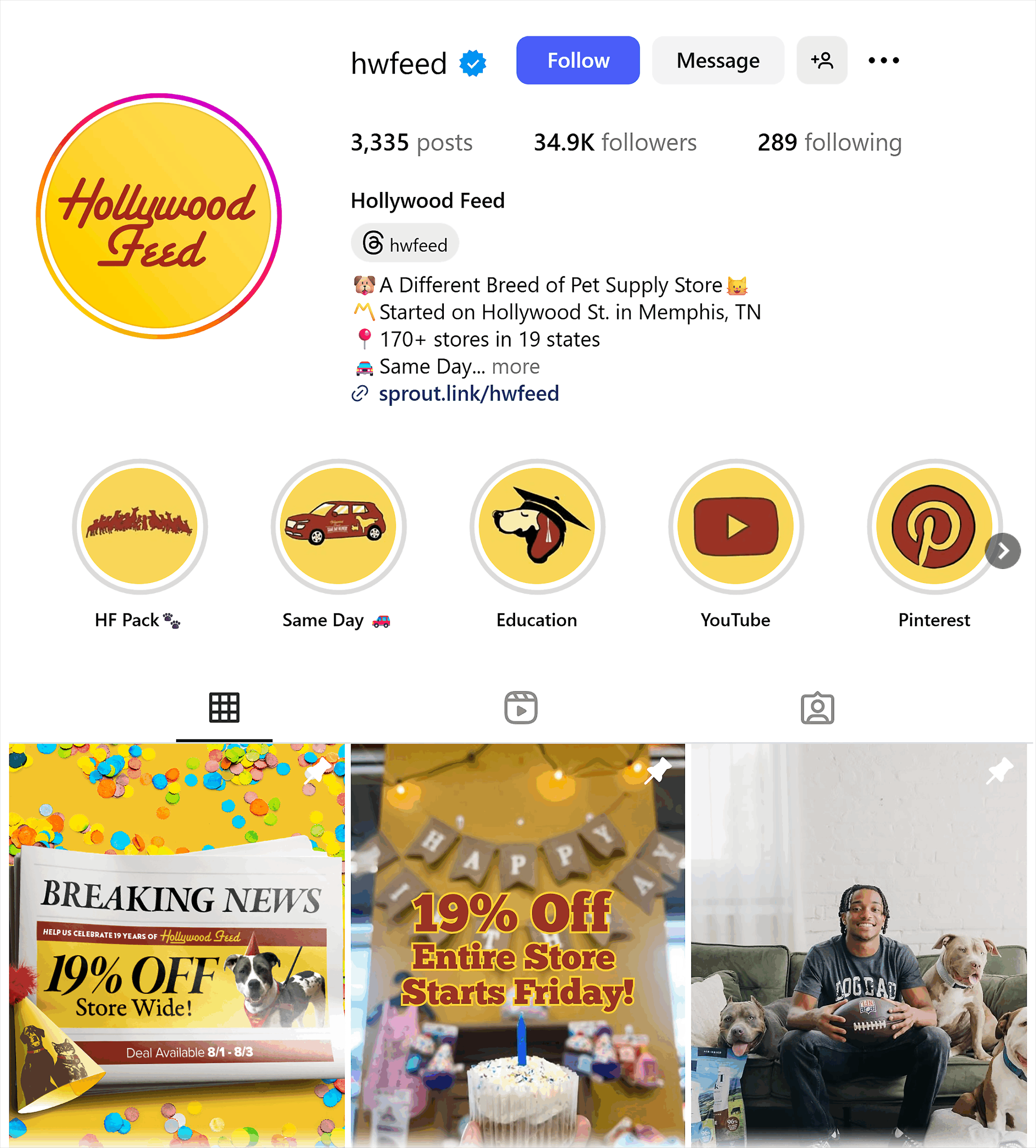
For our pet food example, we find that Hollywood Feed is on Instagram. And they have a large following (around 35K followers).
Their social content leans into friendly, community-focused messaging, with discounts for followers.
You could stand out by adding more educational content.
You might also try more engaging formats, like videos or user-generated posts.
Step 7: Check Their LLM Visibility
Research from Semrush suggests that LLM traffic will overtake Google search by 2027.
That means getting visibility in AI answers is about to matter as much as (or more than) traditional rankings.
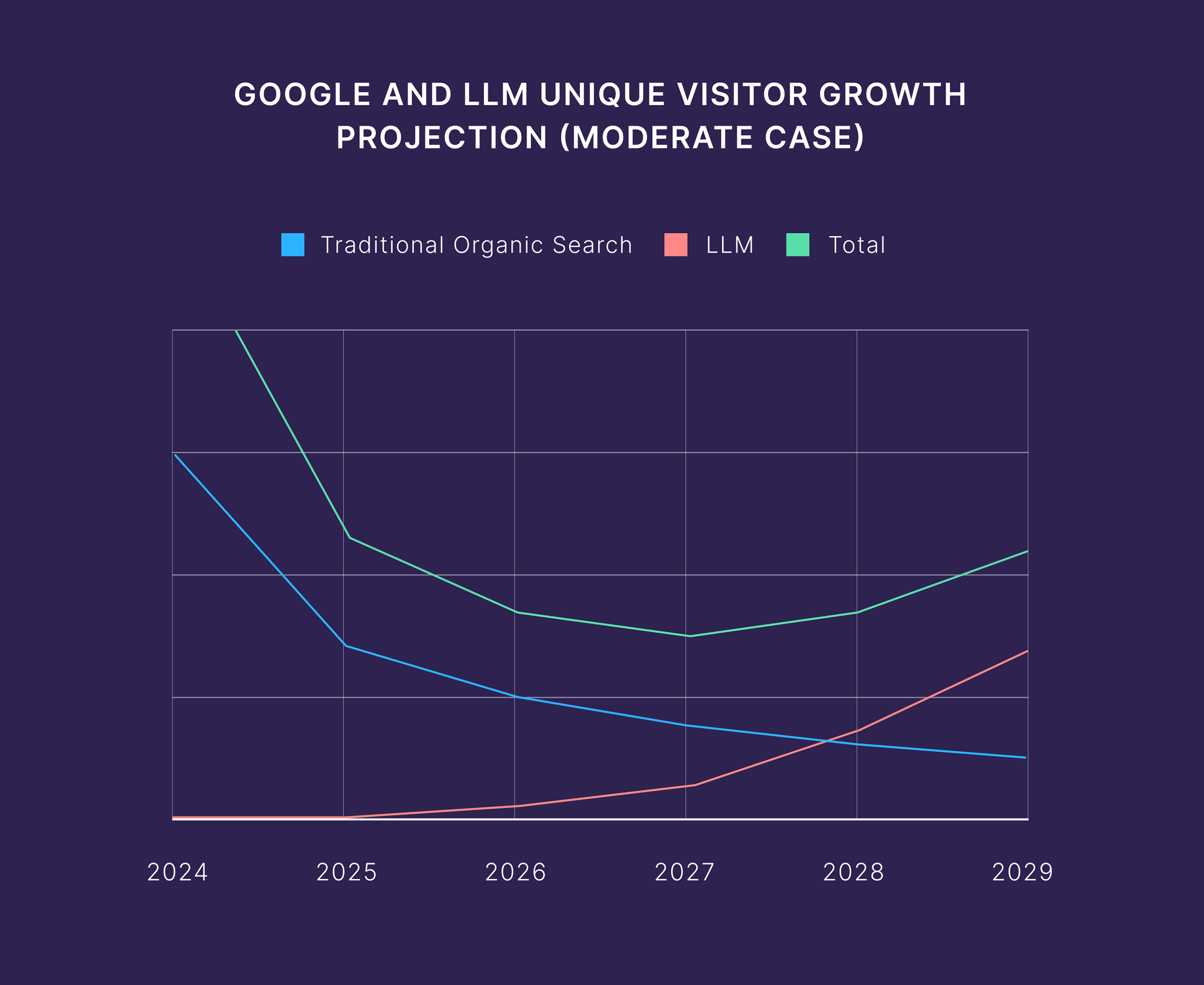
Here’s how to analyze your competitors’ LLM visibility to make sure you’re not falling behind:
First, open a fresh incognito window or use a VPN to avoid personalized results.
Then, in Google Search, look for an AI Overview by searching for broad, high-intent keywords. (Or take a look at the results in AI Mode.)
Think “best dog food delivery” or “top pet stores near me.”
Try the same searches in tools like Perplexity.ai and ChatGPT.
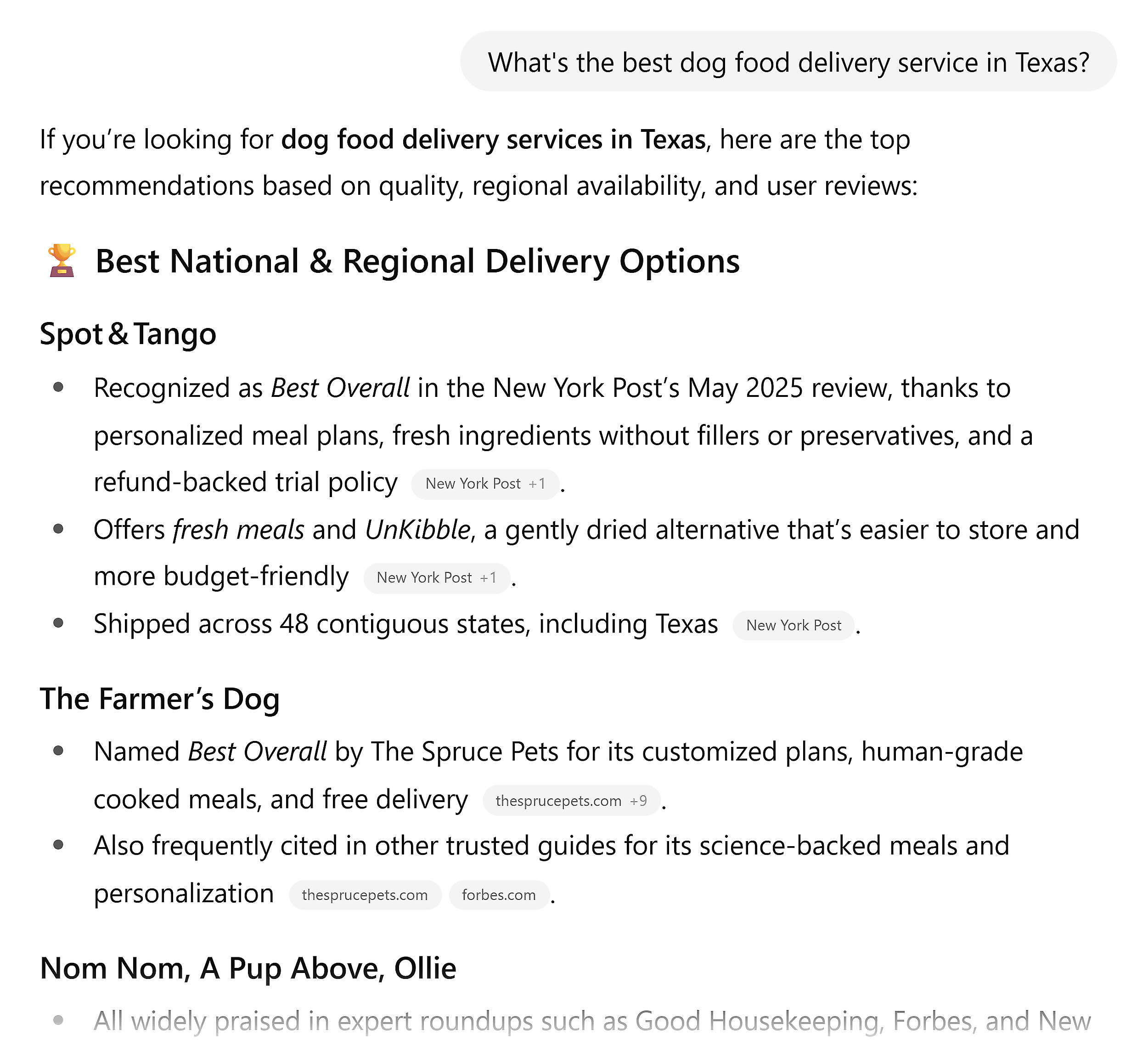
Look for mentions of your competitor’s brand name and links to their site in AI responses.
Also note the sentiment:
- Are they being mentioned as a top brand?
- What specific features are the AI tools calling out?
- Are the AI responses pulling from reviews, or are they also citing round-up posts and forum discussions?
LLM visibility and optimization is a massive topic in its own right. This post would get too long if we tried to cover all the ways you can analyze your competitors’ performance in these tools.
So for a more detailed guide, check out our dedicated article on LLM visibility.
Step 8: Review Their Local SEO (If Applicable)
If your competitor has a physical presence, search for their brand name + city (e.g., “Hollywood Feed Austin TX”) in Google Search and Google Maps.
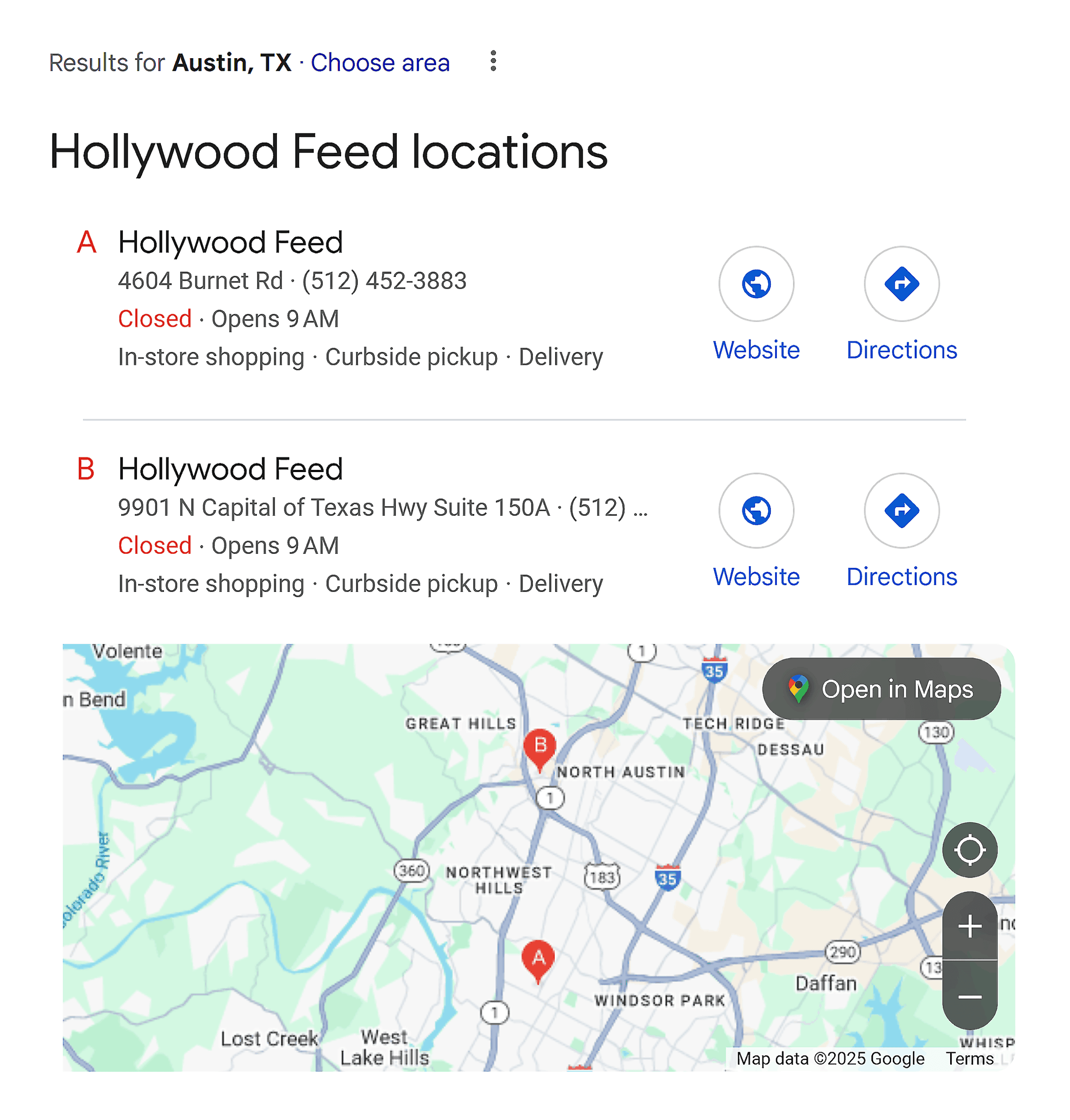
Look for their Google Business Profile.
Is it optimized with photos, opening hours, and reviews?
Do they rank for proximity-based keywords like “pet store near [city]” or “dog food delivery [city]”?
Hollywood Feed appears to be investing in local landing pages.
They have active Google Business Profiles for each store:
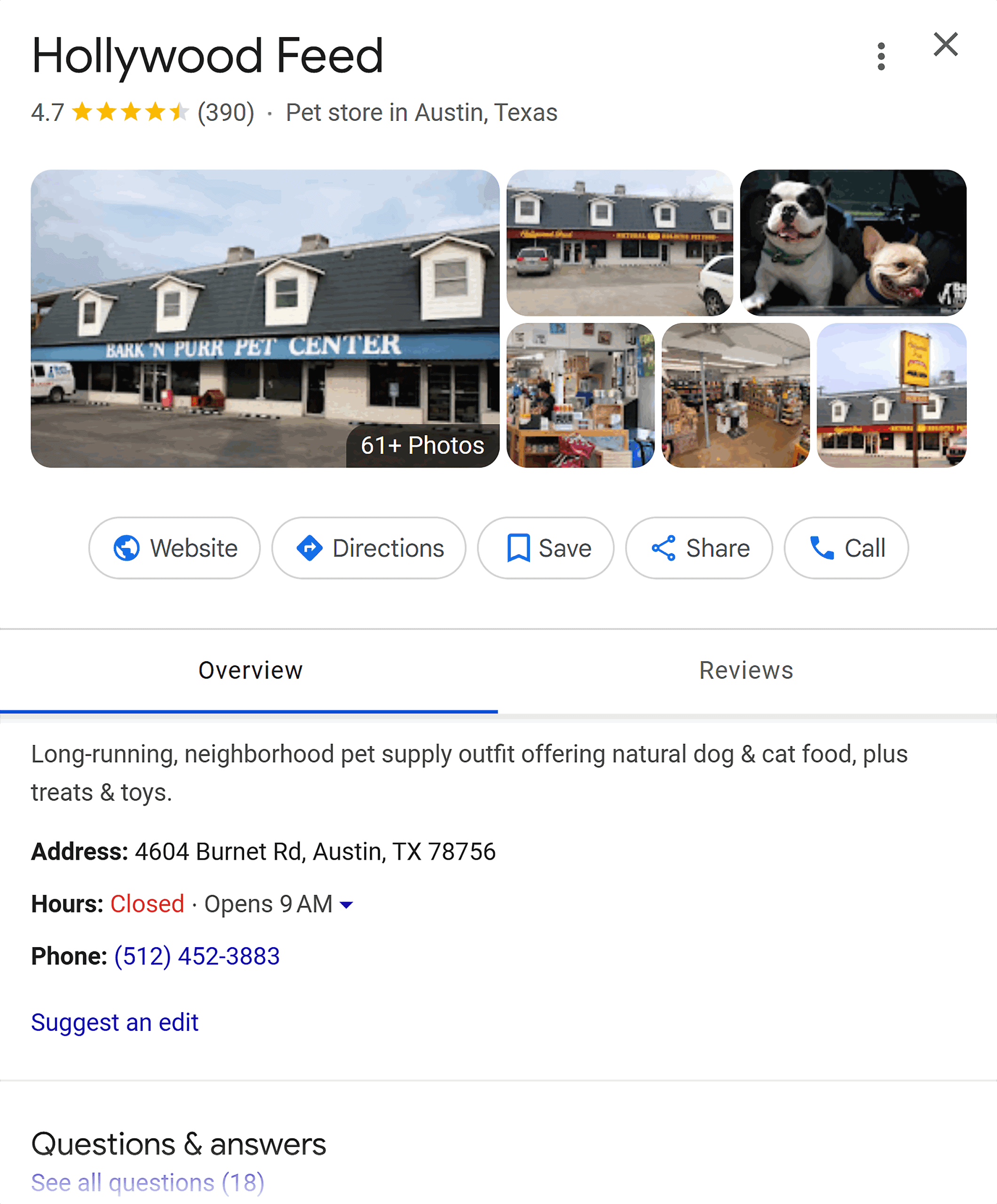
If you wanted to compete on a local search level, you’d better make sure you’ve done the same.
Further reading: Read our Google Business Profile guide to find out how to compete at the local level.
Step 9: Turn Competitive Insights Into Action
Now it’s time to bring all your research together so you can act on it.
If you’ve been following along with our competitor analysis worksheet, you’ll have a lot of info already.
I recommend filling it out for your top 3-5 competitors. Then, download our competitor analysis summary template.
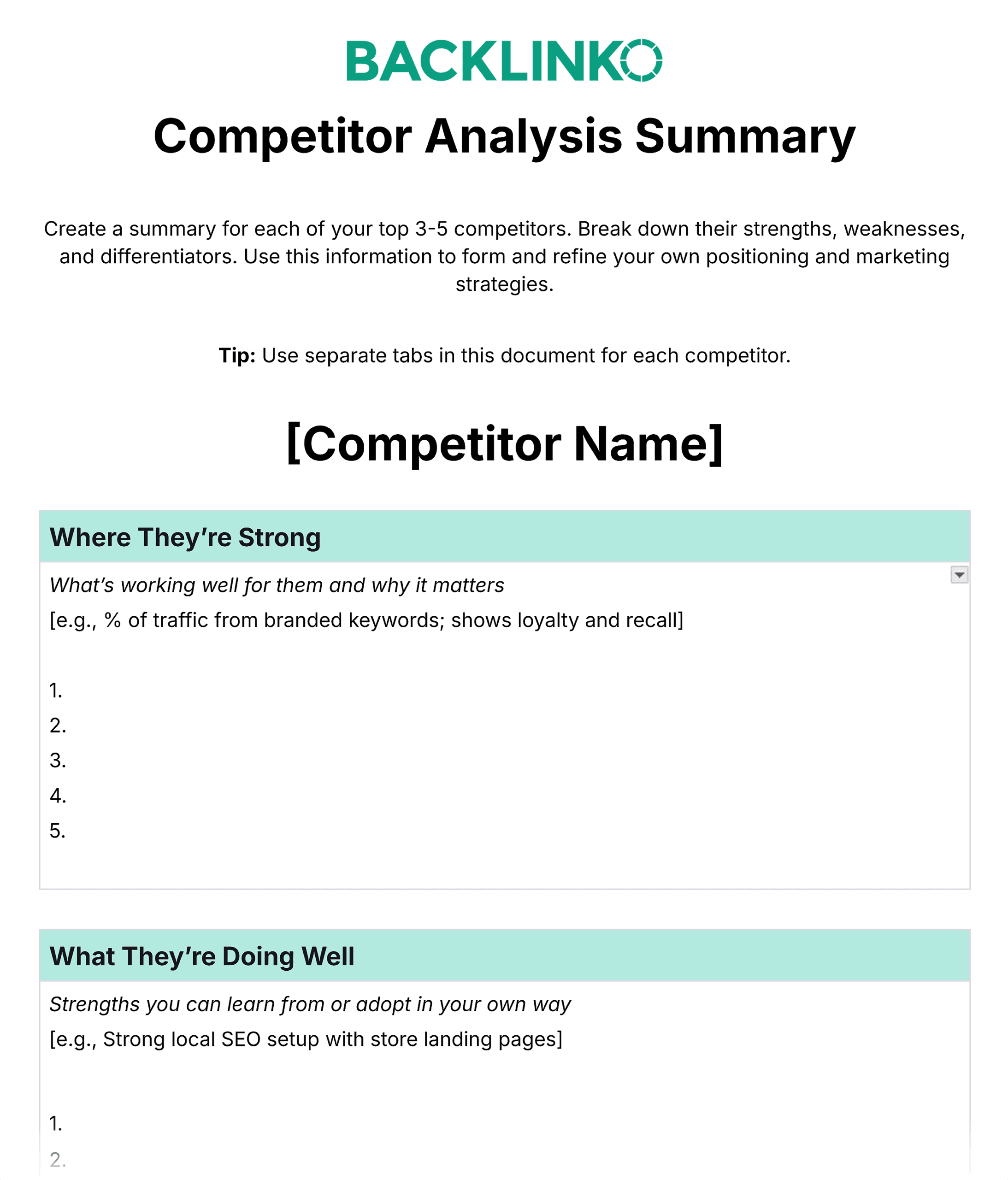
Here’s where you’ll turn data into actionable strategies that you’ll use to beat your rivals.
It helps you dig deeper into what each competitor is doing well, where they’re falling short, and how you can differentiate.
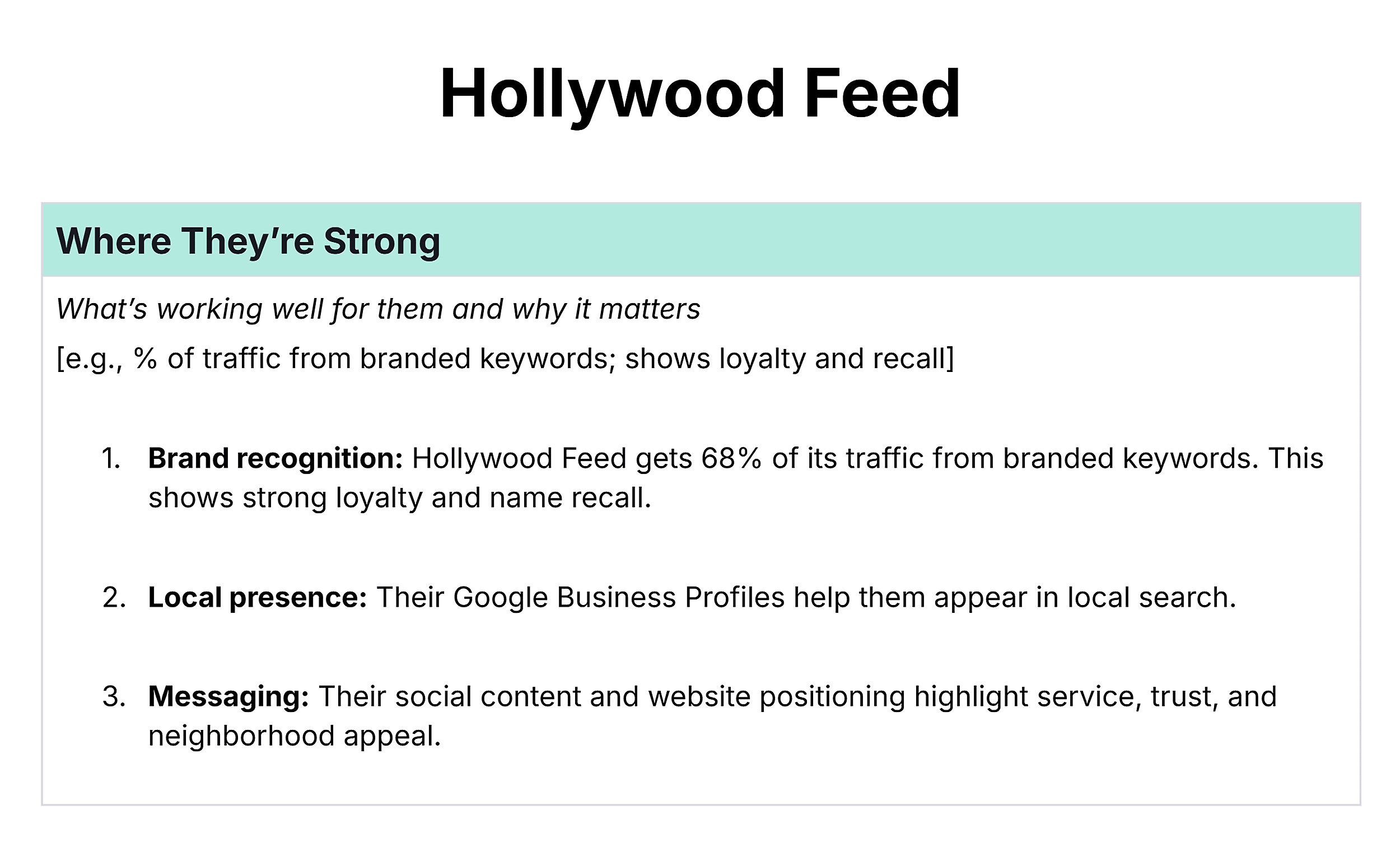
Pro tip: Competitor insights are valuable. But they should never replace your own market research.
Use their playbook as a reference, not a roadmap.
And don’t try to beat them at everything. Find one or two clear openings and double down.
Don’t Just Copy Your Competitors — Outsmart Them
Competitor analysis isn’t about copying. It’s about learning.
Use this process to sharpen your edge, not mirror theirs.
Begin by picking one competitor and analyzing their online presence using the steps in this guide.
To help you get started, download the free Competitive Traffic Analysis Tracker.
Backlinko is owned by Semrush. We’re still obsessed with bringing you world-class SEO insights, backed by hands-on experience. Unless otherwise noted, this content was written by either an employee or paid contractor of Semrush Inc.






